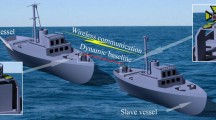Abstract
For precision carrier-based landing aid, the position of reference point on the top of island shall be precisely transferred to the landing point on the deck, so the position transfer error caused by the hull flexure is not negligible. As the existing method is not very applicable to measure the hull flexure, a new technique based on integrated Global Navigation Satellite Systems/Laser Gyro Inertial Navigation System (GNSS/LINS) is proposed in this paper. This integrated GNSS/LINS based measurement method is designed to monitor the hull flexure and set up an integrated GNSS/LINS measurement model based on raw pseudo-range and pseudo-range rate measurement and carrier phase differential positioning measurement to effectively eliminate the measurement error caused by cycle slip and multi-path effect from GNSS. It is shown by demonstration test and analysis that this technique has the capability to precisely measure the hull flexure, with the accuracy being better than 0.02 m.
Similar content being viewed by others
References
Feng T, Mao X. Multimodal data fusion for SRGPS antenna motion error reduction. Multimedia Tools and Applications, 2017, 76(9): 12035–12050
IS A, Ray B. Development and evaluation of a precision coordinate transfer sytem for SRGPS. In: Proceedings of International Technical Meeting of the Satellite Division of the Institute of Navigation, 2004
Wang J, Zhang G. Two-frequency polarization method for metering of instrumentation ship’s hull transverse twist. Optics and Precision Engineering, 1999, 7(3): 118–123
Zhang Y, Li M, Yu P. Research on angle diatortion for the measuring ship. Chinese Journal of Scientific Instrument, 2006, 27(6): 1505–1507
Li Y, Zhang Y, Yue J. New technology of ship distortion measurement. Optics and Precision Engineering, 2008, 16(11): 2235–2238
Sun C, Liu H, Chen S, Zhang X. Semi-physical simulation experimental study of hull vertical deformation measurement based on videometrics principle. Journal of Experimental Mechanics, 2015, 30(5): 599–606
Petovello M G, Lachapelle G, Cannon M E. Using GPS and GPS/INS systems to assess relative antenna motion onboard an aircraft carrier for shipboard relative GPS. In: Proceedings of International Technical Meeting of the Institute of Navigation, 2005, 219–229
Yuan E, Yang G, Yu P, Tang G. Transfer method of ship’s attitude references based on inertial matching method. Ship Science and Technology, 2013, 35(12): 60–64
Zhang Y, Li M, Yu P. Research on angle distortion for the measuring ship. Chinese Journal of Scientific Instrument, 2006, 27(6): 1505–1507
Chen Q J. Research on the Railway Track Geometry Surveying Technology Based on Aided INS. Wuhan: Wuhan University, 2016
Groves P D. Principles of GNSS, Inertial, and Multisensor Integrated Navigation Systems. Boston: Artech House, 2013
Farrell J A. Aided Navigation GPS with High Rate Sensor. New York: The McGraw-Hill Companies, 2008
Dong X R, Zhang S X. GPS/INS Integrated Navigation and Its Application. Changsha: National Defense Science and Technology University Press, 1998
Sun H X. DGPS/INS Integrated Position and Attitude Determination and Its Application in MMS. Wuhan: Wuhan University, 2004
Brown G, Robert, Patrick Y C. Introduction to Random Signals and Applied Kalman Filtering. Vol. 1, No. 1. New York: John Wiley & Sons, 1992
Li Z H, Huang J S. GPS Surveying and Data Processing. Wuhan: Wuhan University Press, 2010
Ning Y P, Wang J, Hu X X, Wang S D. Inertial aided cycle-slip detection and repair for BDS triple-frequency signal in severe multipath environment. Acta Geodaetica et Cartographica Sinica, 2016, 45(S2): 179–187
Author information
Authors and Affiliations
Corresponding author
Additional information
Di Wu is a doctor at the National Space Science Center, Chinese Academy of Sciences. She got the master degree from Beijing Institute of Technology in 2009. Her current fields of interests include digital signal processing of GNSS radio remote sensing, GNSS-R remote sensing techniques, embedded system design, software system design of satellite receiver.
Yu Jia is a senior engineer of Huazhong Institute of Electro-optics—Wuhan National Laboratory for Optoelectronics. He got the master degree from Southwest Jiaotong University in 2005. His current research fields include electro-optical system, laser gyro inertial navigation, multi-sensor navigation information fusion software design, etc.
Li Wang is a senior engineer of Huazhong Institute of Electro-optics—Wuhan National Laboratory for Optoelectronics. He got the doctor degree from Wuhan University in 2015. His current research fields include laser gyro inertial navigation, satellite navigation, multi-sensor navigation information fusion hardware design, etc.
Yueqiang Sun is a professor at the National Space Science Center, Chinese Academy of Sciences. Prof. Sun got her doctor degree from National Space Science Center, Chinese Academy of Sciences, in 2002. She devotes to develop GNSS remote sensing and space-borne special environment exploration technologies. She has been the principal investigator or vice principal investigator of more than twenty missions/projects in manned space flight, FengYun and 863 Project. Her interested research areas include GNSS radio occultation, GNSS-R remote sensing techniques, atmospheric physics, ionospheric physics, magnetic physics, space physics, and so on.
Rights and permissions
About this article
Cite this article
Wu, D., Jia, Y., Wang, L. et al. Ship hull flexure measurement based on integrated GNSS/LINS. Front. Optoelectron. 12, 332–340 (2019). https://doi.org/10.1007/s12200-019-0867-8
Received:
Accepted:
Published:
Issue Date:
DOI: https://doi.org/10.1007/s12200-019-0867-8




